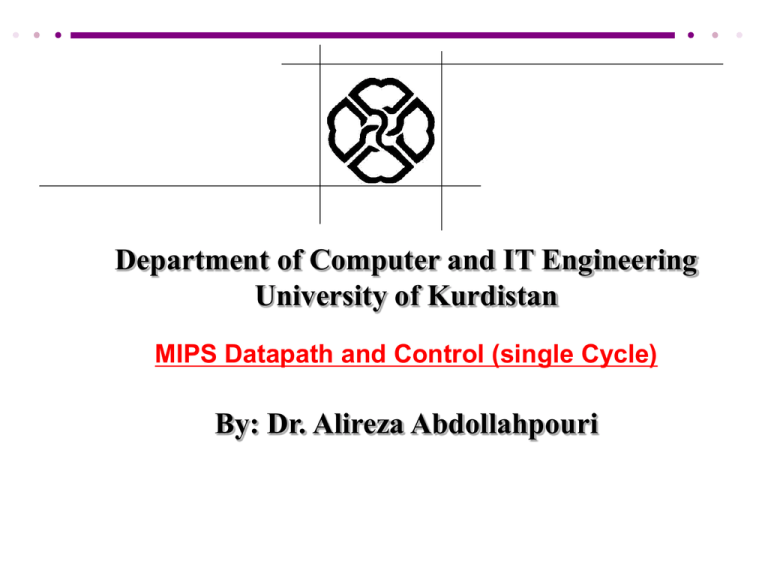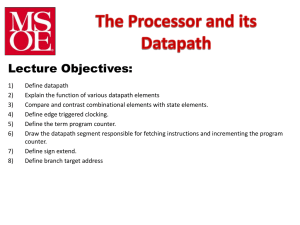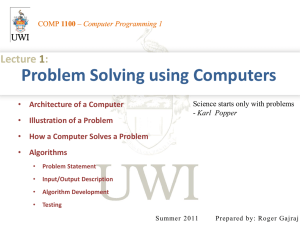ALU
advertisement

Department of Computer and IT Engineering University of Kurdistan MIPS Datapath and Control (single Cycle) By: Dr. Alireza Abdollahpouri A single-cycle MIPS processor Any instruction set can be implemented in many different ways MIPS ISA Single Cycle Short CPI Long CCT Multi-Cycle Long CPI Short CCT Pipelined Short CPI Short CCT 2 All instructions will execute in the same amount of time; this will determine the clock cycle time for our performance equations. در این روش پیاده سازی ،تمامی دستورالعملها برای اجرا به زمان یکسانی احتیاج دارند (یک پالس ساعت) .پس طول کالک باید برابر با طوالنیترین دستورالعمل باشد. 3 The Performance Big Picture Execution Time = IC * CPI * Cycle Time Instruction count is controlled by the ISA and the compiler design Processor design (Datapath and control) will determine: Clock cycle time Clock cycles per instruction Starting today: Single cycle processor: Advantage: CPI = 1 Disadvantage: long cycle time Execute an entire instruction 4 روش اعمال کالک •Needed to prevent simultaneous read/write to state elements •Edge-triggered methodology: state elements updated at rising clock edge State element 1 Combinational logic State element 2 clock input 5 Data Path & Control Unit Data path مسیری است که مشخص میکند داده ها چگونه بین پردازنده و سایر المانهای اصلی رد و بدل میشود .اجزای آن عبارتند از: combinational elements state (sequential) elements Control Unit مشخص میکند که سیگنالهای کنترلی و زمانبندی چگونه به المانهای Data pathمیرسد. 6 روند اجرای دستورات در MIPS واکش ی دستورالعمل از حافظه کدبرداری (دیکد کردن) دستورالعمل خواندن عملوندها اجرای دستورالعمل نوشتن (یا خواندن) ثبت نتیجه در رجیستر مقصد (در صورت لزوم) در پیاده سازی Single-cycleتمامی این مراحل در یک کالک انجام میشوند 7 Instruction and Data Memory ) استفاده میکنیم (دو حافظه جداHarward برای شروع از معماری There will be only one DRAM Main memory But we can have separate SRAM caches (We’ll study caches later) 8 Datapath Schematic Data PC Instruction Memory Address Register # Register # Registers ALU ALU Address Instruction Data Memory Register # Data 9 Instruction Fetch محتوی PCتوسط یک جمع کننده با 4جمع میشود تا آدرس دستور بعدی محاسبه شود. مقدار PCبه حافظه داده میشود تا دستور واکش ی شده و به سایر اجزای Data Pathارسال شود. اگر دستور بعدی پرش باشد ،مقدار PCمتفاوت خواهد بود (بعدا صحبت خواهد شد) 10 ALU Adder 4 Instruction Read address 32 Instruction Memory PC Instruction Decode و سایر فیلدهای الزم دستور به واحد کنترلopcode باید مقدار .فرستاده شوند . رجیسترهای الزم هم از رجیستر فایل خوانده شوند Control Unit Read Addr 1 Instruction Read Read Addr 2 Data 1 Write Addr Write Data Read Data 2 11 The MIPS Instructions 31 R-type add rd, rs, rt sub, and, or, slt 26 op LOAD and STORE lw rt, rs, imm sw rt, rs, imm BRANCH: beq rs, rt, imm rs 6 bits 31 21 6 bits 6 bits 16 rt 5 bits 1. Read 2. Feed 3. Move 26 op 0 5 bits 5 bits 5 bits 5 bits 1. Read registers rs and rt 2. Feed them to ALU 3. Update register file 21 0 immediate 5 bits 16 bits register rs (and rt for store) rs and immed to ALU data between mem and reg 21 rs rd 6 funct rs 6 bits 31 rt 11 shamt 26 op 16 16 rt 0 displacement 5 bits 5 bits 16 bits 1. Read registers rs and rt 2. Feed to ALU to compare 3. Add PC to disp; update PC 12 خواندن عملوندها از رجیستر فایل گانه پردازنده در ساختاری به اسم32 •رجیسترهای .رجیستر فایل نگهداری میشوند •هر یک از رجیسترها را میتوان با مشخص کردن .) بیتی5 شماره آن خواند و یا نوشت (شماره •Register File’s I/O structure –3 inputs derived from current instruction to specify register operands (2 for read and 1 for write) –1 input to write data into a register –2 outputs carrying contents of the specified registers 5 Register 5 numbers 5 Data 32 Read reg 1 Read data 1 32 Read reg 2 Registers Write reg Write data Read data 2 32 RegWrite برای کنترل عملیات نوشتن •Register file’s outputs are always available on the output lines 13 Register File خواندن نوشتن 14 سایر مدارات •Multiplexor selects one out of 2n inputs ALU operation Function 000 and 001 or 010 add 110 sub 111 slt (set less than) others don’t care M 2n 1 U X n 32 ALU 32 zero 32 result 3 ALU operation 15 Datapath Building Blocks: R-Type Instruction zero R[rd] R[rs] op R[rt] 16 Datapath Building Blocks: R-Type Instruction برای دستورات محاسباتی و منطقی که توسط این فرمت نشان داده میشوند الزم است تا دو رجیستر( )rs, rtاز رجیستر فایل خوانده شده و داده آنها به ALUمنتقل شود. عمل ALUبر اساس نوع دستور تعیین شده و بر روی محتوی رجیسترها انجام میشود. نتیجه در رجیستر مقصد ( )rdنوشته میشود( .سیگنال RegWriteباید فعال گردد) سیگناهای کنترلی باید ایجاد شود تا نتیجه در لبه کالک در رجیستر مقصد نوشته شود. همچنین سیگنال ALUopباید تولید شود تا عمل ALUرا تعیین کند. 6 func 17 5 5 5 5 rd shamt rt rs 6 R-Type opcode I-Type Instruction: load/store برای محاسبه آدرس باید مقدار افست 16بیتی موجود در دستورالعمل بصورت یک عدد عالمت دار 32بیتی تبدیل شده وبا مقدار پایه موجود در rs جمع شود. 18 16 5 5 immediate rt rs 6 I-Type opcode )LW R2, 232(R1 )SW R5, -88(R4 32 sign extend 16 Load Instruction Steps lw $rt, offset($rs) 1. 2. 3. 4. 5. R[rt] Mem[R[rs] + SignExt[imm16]] Fetch instruction and increment PC Read base register from the register file: the base register ($rs) is given by bits 25-21 of the instruction ALU computes sum of value read from the register file and the sign-extended lower 16 bits (offset) of the instruction The sum from the ALU is used as the address for the data memory The data from the memory unit is written into the register file: the destination register ($rt) is given by bits 20-16 of the instruction 19 Datapath for Load Operations 31 26 op 6 bits 21 rs 5 bits 16 rt 5 bits 0 immediate 16 bits 20 Datapath for Store Operations Mem[R[rs] + SignExt[imm16]] R[rt] 31 26 op 6 bits 21 rs 5 bits 16 rt 5 bits 0 immediate 16 bits 21 Combining datapaths RegWrite ALU operation Read Reg.1 Read Read Reg.2 Data 1 Write Data ALU Read Data 2 Sign 16 Extend Mux Write Reg. zero ALUSrc استفاده از مالتی پلکسربا ALUsrc سیگنال کنترلی 0=register 1=immediate 32 22 Datapath for Branch Operations 0 16 immediate 16 bits 21 rt 5 bits 26 rs 5 bits 31 op 6 bits مقصد پرش مقصد دستور انشعاب از جمع مقدار افست با PCبدست می آید. از آنجائیکه این مقصد باید مضربی از 4باشد ،نیاز است تا مقدار افست 2بار به سمت چپ شیفت داده شود. Branch Instruction Steps beq $rs, $rt, offset 1. 2. 3. 4. Fetch instruction and increment PC Read two register ($rs and $rt) from the register file ALU performs a subtract on the data values from the register file; the value of PC+4 is added to the signextended lower 16 bits (offset) of the instruction shifted left by two to give the branch target address The Zero result from the ALU is used to decide which adder result (from step 1 or 3) to store in the PC 24 برای مقایسه رجیسترهای دستور beqاز ALUاستفاده میشود (عمل تفریق) .از اینرو نتیجه این مقایسه با سیگنال Zeroکه در خروجی ALUتعبیه شده است مشخص میگردد. بعلت درگیر بودن ،ALUبرای محاسبه آدرس مقصد از یک جمع کننده دیگر استفاده میشود. 25 Branching hardware We need a second adder, since the ALU is already doing subtraction for the beq. Multiply constant by 4 to get offset. PCSrc=1 branches to PC+4+(offset4). PCSrc=0 continues to PC+4. 26 27 اجزای مورد نیاز برای قسمت های مختلف در کنار هم قرار داده شده و سیگناهای کنترلی و مالتی پلکسرهای مورد نیاز به آن افزوده میشوند. در طراحی Single Cycleهمه مراحل واکشی ،دیکد و اجرا در یک کالک انجام میشود! زمان این کالک برابر خواهد بود با زمان الزم برای طی کردن طوالنی ترین مسیر که میتواند زمان زیادی باشد. عالوه برآن امکان به اشتراک گذاشتن سخت افزار برای عملیات یکسان وجود ندارد. All together: the single cycle datapath 28 The R-Format (e.g. add) Datapath ALUsrc=1, ALUop=“add”, MemWrite=0, MemToReg=0, RegDst = 0, RegWrite=1 and PCsrc=1. 29 The Load Datapath What control signals do we need for load?? 30 The Store Datapath Mem[R[rs] + SignExt[imm16]] R[rt] 31 Datapath + Control 32 ALU Control Plan to control ALU: main control sends a 2-bit ALUOp control field to the ALU control. Based on ALUOp and funct field of instruction the ALU control generates the 3-bit ALU control field ALU operation Function 000 and 001 or 010 add 110 sub 111 slt (set less than) 2 ALU must perform Main Control Unit ALUOp ALU Control 3 ALU control input To ALU 6 Instruction funct field add for load/stores (ALUOp 00) sub for branches (ALUOp 01) one of and, or, add, sub, slt for R-type instructions, depending on the instruction’s 6-bit funct field (ALUOp 10) 33 طراحي واحد کنترل ALU 34 طراحي واحد کنترل ALU ALUop 2 3 ALU 35 operation ALU Control 6 واحد کنترل اصلی 6 ]Instr[31-26 ) Functشش بیت سمت راست دستورالعمل( طراحي واحد کنترل ALU 36 Designing the Main Control R-type opcode 31-26 Load/store or branch opcode 31-26 rs 25-21 rt 20-16 rs rt 25-21 20-16 rd 1511 shamt 10-6 funct 5-0 addres s 15-0 Observations about MIPS instruction format opcode is always in bits 31-26 two registers to be read are always rs (bits 25-21) and rt (bits 20-16) base register for load/stores is always rs (bits 25-21) 16-bit offset for branch equal and load/store is always bits 15-0 destination register for loads is in bits 20-16 (rt) while for R-type instructions it is in bits 15-11 (rd) (will require multiplexor to select) 37 Control Signals Signal Name RegDst AlLUSrc MemtoReg RegWrite PCSrc 0 The register destination number for the Write register comes from the rt field (bits 20-16) The second ALU operand comes from the second register file output (Read data 2) The value fed to the register Write data input comes from the ALU None MemRead The PC is replaced by the output of the adder that computes the value of PC + 4 None MemWrite None Instruction R-format lw sw beq OP-code 000000 100011 101011 000100 1 The register destination number for the Write register comes from the rd field (bits 15-11) The second ALU operand is the sign-extended, lower 16 bits of the instruction The value fed to the register Write data input comes from the data memory The register on the Write register input is written with the value on the Write data input The PC is replaced by the output of the adder that computes the branch target Data memory contents designated by the address input are put on the first Read data output Data memory contents designated by the address input are replaced by the value of the Write data input Memto- Reg Mem Mem RegDst ALUSrc Reg Write Read Write 1 0 0 1 0 0 0 1 1 1 1 0 X 1 X 0 0 1 X 0 X 0 0 0 PCSrc ALUOp 1,0 0 10 0 00 0 00 1 01 38 Control Signals: R-Type Instruction ADD 0 M U X ADD ADD 4 rs I[25:21] PC rt I[20:16] rd I[15:11] Instruction ADDR RD Instruction Memory I 32 5 0 5 5 RN1 RN2 RegDst 1 5 WN RD1 Register File WD immediate/ offset I[15:0] ??? Operation Value depends on funct 3 ALU 0 Zero 0 M U X RD2 RegWrite 1 Control signals shown in blue PCSrc 0 1 MUX 16 1 <<2 16 E X T N D 1 32 ALUSrc 0 0 MemWrite ADDR Data Memory MemtoReg 1 RD M U X WD MemRead 0 0 39 Control Signals: lw Instruction ADD 0 M U X ADD ADD 4 rs I[25:21] PC rt I[20:16] rd I[15:11] Instruction ADDR RD Instruction Memory I 32 5 0 5 5 RN1 RN2 RegDst 0 5 WN RD1 Register File WD immediate/ offset I[15:0] 010 Operation 3 ALU 0 Zero 0 M U X RD2 RegWrite 1 Control signals shown in blue PCSrc 0 1 MUX 16 1 <<2 16 E X T N D 1 32 ALUSrc 1 1 MemWrite ADDR Data Memory MemtoReg 1 RD M U X WD MemRead 0 1 40 Single-cycle Implementation Notes The steps are not really distinct as each instruction completes in exactly one clock cycle – they simply indicate the sequence of data flowing through the datapath The operation of the datapath during a cycle is purely combinational – nothing is stored during a clock cycle Therefore, the machine is stable in a particular state at the start of a cycle and reaches a new stable state only at the end of the cycle Very important for understanding single-cycle computing: 41 Implementation: Main Control Block Signal R-type lw sw beq Inputs Op5 Outputs Inputs Op4 Op5 Op4 Op3 Op2 Op1 Op0 RegDst ALUSrc MemtoReg RegWrite MemRead MemWrite Branch ALUOp1 ALUOP2 0 0 0 0 0 0 1 0 0 1 0 0 0 1 0 1 0 0 0 1 1 0 1 1 1 1 0 0 0 0 1 0 1 0 1 1 x 1 x 0 0 1 0 0 0 0 0 0 1 0 0 x 0 x 0 0 0 1 0 1 Truth table for main control signals Op3 Op2 Op1 Op0 Outputs R-format Iw sw beq RegDst ALUSrc MemtoReg RegWrite MemRead MemWrite Branch ALUOp1 ALUOpO Main control PLA (programmable logic array): principle underlying PLAs is that any logical expression can be written as a sum-of-products Single-Cycle Design Problems Assuming fixed-period clock every instruction datapath uses one clock cycle implies: CPI = 1 cycle time determined by length of the longest instruction path (load) but several instructions could run in a shorter clock cycle: waste of time consider if we have more complicated instructions like floating point! resources used more than once in the same cycle need to be duplicated waste of hardware and chip area 43 Fixing the problem with single-cycle designs One solution: a variable-period clock with different cycle times for each instruction class unfeasible, as implementing a variable-speed clock is technically difficult Another solution: use a smaller cycle time… …have different instructions take different numbers of cycles by breaking instructions into steps and fitting each step into one cycle feasible: multicyle approach! 44 مزایا و معایب معماری Single Cycle زمان کالک بطور موثر استفاده نمیشود زیرا بر اساس طوالنی ترین دستور تنظیم شده است .این امر در صورت داشتن دستورات پیچیده مثل دستورات اعشاری میتواند خیلی وخیم باشد. فضای بیشتری در روی چیپ الزم دارد زیرا تعداد بیشتری از املانهای سخت افزاری الزم دارد. ساده و قابل فهم است. Cycle 2 Cycle 1 Clk Waste 45 sw lw محاسبه طوالنی ترین دستورالعمل Instruction class Instruction memory Register read ALU operation Data memory Register write Total (ps) R- type 200 50 100 0 50 400 lw 200 50 100 200 50 600 Sw 200 50 100 200 Branch 200 50 100 550 350 طول کالک باید بر اساس زمان الزم برای طوالنی ترین دستور 600 ps .طراحی شود 46 A Multicycle Implementation Clock Time needed Time allotted Instr 1 Instr 2 Instr 3 Instr 4 Clock Time needed Time allotted Time saved 3 cycles 5 cycles 3 cycles 4 cycles Instr 1 Instr 2 Instr 3 Instr 4 Single-cycle versus multicycle instruction execution. 47 Questions 48 Datapath Building Blocks: jump instruction اجرای دستور jumpاز طریق المانهای زیر انجام میشود: 26 بیت مقدار موجود در دستورالعمل به اندازه 2بیت به سمت چپ شیفت داده شده و با 28بیت کم ارزش PCجایگزین میشود. Add 4 4 Jump address 28 Shift left 2 Instruction Memory Instruction 26 Read Address PC Example: Fixed-period clock vs variable-period clock in a single-cycle implementation Consider a machine with an additional floating point unit. Assume functional unit delays as follows Assume instruction mix as follows memory: 2 ns., ALU and adders: 2 ns., FPU add: 8 ns., FPU multiply: 16 ns., register file access (read or write): 1 ns. multiplexors, control unit, PC accesses, sign extension, wires: no delay all loads take same time and comprise 31% all stores take same time and comprise 21% R-format instructions comprise 27% branches comprise 5% jumps comprise 2% FP adds and subtracts take the same time and totally comprise 7% FP multiplys and divides take the same time and totally comprise 7% Compare the performance of (a) a single-cycle implementation using a fixedperiod clock with (b) one using a variable-period clock where each instruction executes in one clock cycle that is only as long as it needs to be (not really practical but pretend it’s possible!) Solution Instruction class Load word Store word R-format Branch Jump FP mul/div FP add/sub Instr. Register ALU mem. read oper. 2 2 2 2 2 2 2 1 1 1 1 1 1 2 2 2 2 Data mem. 2 2 0 Register FPU write add/ sub FPU mul/ div 1 1 1 1 16 8 Total time ns. 8 7 6 5 2 20 12 Clock period for fixed-period clock = longest instruction time = 20 ns. Average clock period for variable-period clock = 8 31% + 7 21% + 6 27% + 5 5% + 2 2% + 20 7% + 12 7% = 7.0 ns. Therefore, performancevar-period /performancefixed-period = 20/7 = 2.9










